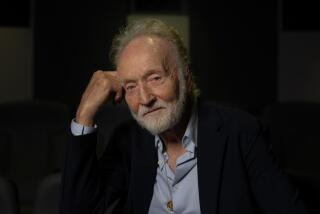Operation Desert Talk : Art Bell sets his national radio show apart with a mix of the topical and unsettling. You wouldn’t find Rush transmitting solo from a home in Nevada, would you?
- Share via
PAHRUMP, Nev. — Talk-radio host Art Bell is talking about how he realized when his big break came: At the end of 1994, Los Angeles’ late-night fixture Ray Briem left KABC-AM (790), and a vacuum had to be filled. Briem loved eccentric nocturnal callers; so does Bell. Briem adored ham and amateur radio; so does Bell. Briem was firmly on the political right; Bell, on many issues, leans to the right.
“It seemed that I would be the perfect replacement for him,” Bell says in the living room of his tidy, prefabricated home on the far outskirts of this Nevada desert town, 50 miles northwest of Las Vegas. A leading station in the country’s No. 2 market would mark a huge leap for Bell’s accumulation of affiliates.
Instead, Ira Fistell was chosen to replace Briem. When Bell finally was picked up in L.A. months later, it was by KABC’s lower-rated sister station, KMPC-AM (710). Then last September, KABC decided to oust Fistell and bring over Bell’s show to fill the 11 p.m.-4 a.m. weeknight slot.
But just as Bell is relishing his late-night victory, the power goes out in the house--and across Pahrump. For a man so plugged into the world, a power outage is not a pretty thing.
For one thing, multiple fax machines, computers and a television--all key tools for Bell’s everyday, essential news-gathering--are out cold. For another, there’s no knowing how long the outage will last.
Most critical, though, is the radio station. For the radio station--the room from which Bell broadcasts to 245-and-counting affiliated stations--is just down the hallway from the living room.
From here, Bell is his own producer, engineer and host, proudly boasting no screening of incoming calls. On one side of the converted bedroom is the broadcast booth, while in other corners are his ham radio set and his computer.
The radio signal is beamed from the Bell family backyard--populated with dishes and antennae--via a complex bicoastal satellite system, to a network whose nighttime reach stretches from the Arctic to South America.
“If this keeps going, we’re in big trouble,” says Bell, scrambling from room to room to check his equipment. He and wife Ramona are prepared with a backup generator for their home, but Bell’s show, “Coast to Coast AM,” is another matter.
Bell surveys the situation, realizes there’s nothing to be done but wait, and settles back down to talk about talk--and how he’d like to change the direction of it on the radio in the ‘90s.
“Talk radio is the No. 1 format in America, but it’s not going to stay that way unless it broadens,” he says. “I know it sounds terribly egotistical, but I think my show is leading talk radio down a more productive, long-term path, which offers a more general reflection of life, something more spontaneous. I don’t want to be the kind of guy where, if you listen once every two weeks, you know it’s the same shtick.”
Bell is thinking, of course, of Rush Limbaugh and his regular, daily attacks on Bill Clinton’s Democrats and his defense of Newt Gingrich’s Republicans. “If I had to go on and talk about politics for five hours a night, I’d rather slit my wrists,” he notes acidly.
Instead, Bell, 50, is a complex reflection of his environs. Rather than the hammering, testosterone-driven verbal style of most daytime talk hosts, Bell brings an FM kind of voice to AM, a desert-like calm instead of urban chatter. Like a recluse on the mount, Bell observes the issues of the country and the world as a whole, equally critical of the right’s militia movement and the left’s abortion-rights movement.
He is very Western United States in two contrary ways: Like much of the rural West, he bemoans federal government initiatives and strongly opposes gun control; like many in the New Age movement (still strongest in the West), he is fascinated with the paranormal and the unexplained, from Bigfoot and UFOs to crop circles and claims of archeological findings on other planets.
“What has fueled Bell’s growth,” says Eric Rhoads, publisher of Radio Ink magazine, “is that he’s offering more of an apolitical bent on all-night radio, which wasn’t always available. He’ll continue to grow. The magic of Art is that he’s not belligerent, not a curmudgeon, sounds like a nice guy and, unlike the rest of the pack, he’s not afraid of talking about really strange stuff.”
How strange? A recent evening had Bell and his callers talking about body piercing, radio beyond the third dimension, the Washington budget struggles and the underground Church of the Sub-Genius, which even the eclectic Bell admitted he had never heard of.
Bell doesn’t stop, though, at “Coast to Coast AM.” His Sunday night show, “Dreamland” (named after the secretive military sector north of Pahrump, also known as “Area 51”), is his bid for taking AM radio into outer space as it focuses on avant-garde science and the paranormal. (While San Diego’s KOGO-AM airs “Dreamland,” KABC does not but is “considering it a possibility in the future,” says operations manager Al Brady Law.)
*
It isn’t as if Bell had parents like the ones in “3rd Rock From the Sun.” The only child of military folk, Bell moved around a lot as a kid and kept from being bored by doing things like experimenting with a battalion’s worth of cherry bombs in his backyard or getting into ham radio.
Bell was so hooked on radio that in the Air Force, he created an on-base pirate radio station. For a time, he held the Guinness world record for staying on-air the longest (115 hours), and he worked as a rock jock at 25 stations. “The gypsy life,” as he calls it, got to him, but he was eventually lured into talk radio at KDWN-AM in Las Vegas in the mid-1980s, where he mastered his blend of the topical and unsettling.
The power is back on, and as he points out the window facing in the direction of Area 51, a visitor can understand Bell’s attraction to the unexplainable.
“We have seen some very odd things coming from over there at night, things moving like no airplane you’ve ever seen.” They remind him of some of the gravity-defying technology described on recent shows by one of his most frequent guests, astronomy lecturer Richard Hoagland, who has been investigating Comet Hale-Bopp and supposed signs of pyramids and buildings on martian and lunar surfaces.
Press Bell on his ideas, though, and his contradictions show: He admits that “I really do yearn for America returning to an ‘Ozzie and Harriet’ time, when the streets were safe,” but at the same time insists that the world has perhaps pushed environmental, economic and social stresses past the limit, “a point of no return where things are going to radically change into . . . something else. What? I don’t know. It may be a new consciousness, it may be cataclysm.”
The term Bell has coined for the accelerated changes is “The Quickening,” and recent shows have explored such sleep-disturbers as self-described prophet Gordon-Michael Scallion predicting big quakes on the Pacific “Ring of Fire” (including Los Angeles) and researcher Dr. Nick Begich reporting on the U.S. military-sponsored High-Frequency Active Auroral Research Program--a shadowy experiment, Begich claims, for using electromagnetic waves as a weapon.
“I’m no prophet, though, and I’m not a doomsayer,” Bell says. “I want to bring topics on radio you otherwise might not hear. But I dissect the news every day in preparation for going on the air, and there are pragmatic reasons for sensing this Quickening. I don’t want it to mean ‘The End.’ I want to see, as Paul Harvey would say, the rest of the story.”
More to Read
The complete guide to home viewing
Get Screen Gab for everything about the TV shows and streaming movies everyone’s talking about.
You may occasionally receive promotional content from the Los Angeles Times.






